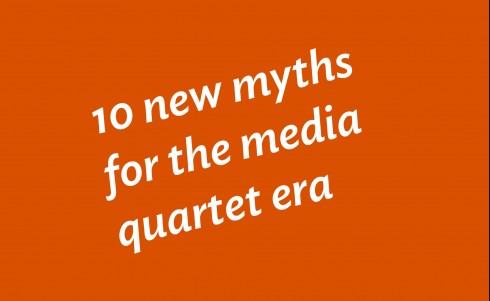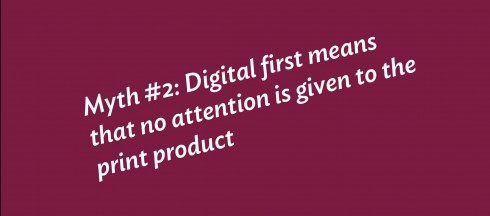TAKEAWAY: Here are 10 myths that apply to the new digital age. What would newsrooms be without those myths, past and present?

Myths exist in every field of endeavor, no doubt.
Perhaps we who work in newsrooms DO have a larger share of them, and I love to hear them echoed as I move from one newsroom to the next.
I am particularly interested when someone attaches a myth to my name, as when someone tells me: “We abandoned italics in captions because someone said that YOU hated it.”
No such thing, I swear.
Or, “You killed the use of ragged right for briefs here, we are told.”
Did I? I can’t remember a day when I did not favor ragged right for briefs or anything else.
From time to time, I have refreshed those myths in this blog, and they also appear in some of my books.
But, wait a minute, we are suddenly creating new myths in the new digital world of the media quartet. And, as you can imagine, these myths travel faster via social media. What is one to do? For starters, be more careful what words you utter in the presence of attentive editors and designers.
Here are some of the new myths:

1. Print is dead.
No such thing at all. Print is finding its way and fine tuning its instrument as part of the media quartet. In some cases, old newspapers are rethinking themselves, as in the case of the Orange County Register, while new printed products appear, as in the Long Beach Telegram. Melancholic attitudes about print have given way to optimism and a new way of approaching the role of print.
2. Digital first means that no attention is given to the print product.
It is all about the story. Stories will appear in all four platforms of the media quartet, but it is how those stories are played in each platform that makes the difference. Mobile platforms allow for story enhancements and appeal to the senses in ways that print can’t replicate. Good editors in a multi platform world know the role of print and act accordingly: emphasize the long narrative, design with illustrations and excellent showcasing of typography. These editors do print happily.
3. The tablet is a totally lean-back (evening) experience
At first we thought it was, and perhaps, in its infancy, the tablet was totally lean back, a treat we saved for the end of our day, when we could lie on the couch, take off our shoes and give ourselves to the enjoyment of a long story with videos and photo galleries. But, not any more: many now carry those tablets around all day. It is lean forward in the working hours, lean back in the evening. The everywhereness of the tablet is new and worth examining.
4. It is impossible to attempt multimedia storytelling unless you are a big metropolitan daily.
Who says so? Multimedia storytelling begins as a state of mind, when editors and designers tell themselves: we are going to approach this story across platforms, we will appeal to the senses, and we will milk the content of the story for all possibilities. It does require a variety of skills, but such skills are available in most newsrooms I have ever visited. Someone has to spot the talent, then use it.
5. Journalists of a certain age cannot be trained to think digitally.
Age has nothing to do with it. Attitude does. I have seen 40 year olds who refuse to get on with the program, but 60+ editors who relish the digital opportunities for storytelling (count me among them!). But education plays a role. Everyone in a newsroom is there because he/she loves to tell stories. Today we have the best possibilities to tell stories in a variety of platforms, and that is the most convincing argument to convert editors of any age to the digital side.
6. Including branded journalism style advertising is compromising ethical standards.
This is an old argument which is often used to avoid the challenges of examining how advertising is presented. Branded journalism is labeled as such. Our audience is smart and savvy.
While journalists need the revenue, brands need the exposure. Bring the two together and it is a win win, with no ethical standards violated.
7. Responsive design is a sure way to kill creativity.
Creativity has nothing to do with responsive design’s possibilities. It all begins with creative sketches which are then transferred to the most functional mode of responsive design. First come creation, then execution.
8. People don’t read much text on smartphones.
That may have been true, but it is changing alarmingly quickly. Some of us may not like to read a long story on a smartphone, but many already do—consider the popularity of “read it later” apps like Instapaper** and Pocket on smartphones as well as tablets. I predict that a generation of kids who use smartphones for every aspect of their lives will not find it unusual or challenging to read a long story on the screen of their iPhone.
9. As printed newspapers have lost the time advantage, there are no ways to surprise the readers.
Surprises have nothing to do with breaking news. Editors can surprise with the headline they write (make it a headline that advances the story to the future, if possible), with the story and photo they choose. Designers can surprise with the presentation.
10. Older readers are not into mobile devices.
Not true. Not if you look around you when at an airport lounge waiting for your flight, or while having breakfast at a popular restaurant, or when strolling down the beach. In fact, older readers have the money and the time to invest in mobile devices. They also favor tablet reading, as they can make the text larger if necessary. The baby boomer generation (of which I am a proud member) is especially adept with everything digital.
Be sure to print these myths and put them somewhere visible in your newsroom, chances are that they are already gaining a life of their own in your midst.
And, by the way, if someone tells you I killed “dog legs” in her newspaper in 1981, that is no myth. But, oh, what great delight it is to break your own myth, as we now are doing in a current project.
Myths, too, are meant to be revisited.

These blog posts demystified some of the myths:
1. Print is dead.
Print is back, but did it ever leave?
https://garciamedia.com/blog/articles/print_is_back_but_did_it_ever_really_leave/
Orange County Register fueling optimism for newspaper industry
https://garciamedia.com/blog/articles/porange_county_register_fueling_optimism_for_newspaper_industry_p
Newsprint is back in California
https://garciamedia.com/blog/articles/newsprint_is_back_in_calfornia
2. Digital first means that no attention is given to the print product.
Thoughts on doing the printed newspaper happily
https://garciamedia.com/blog/articles/thoughts_on_doing_the_printed_newspaper_happily
Charlotte Business Journal: it’s new look, new digital focus as part of Project Pinstripe
https://garciamedia.com/blog/articles/pcharlotte_business_journal_its_new_look_new_digital_focus_as_part_of_pinst
Front pages that project stories and readers to the next level
https://garciamedia.com/blog/articles/pfront_pages_that_project_stories_and_readers_to_the_next_level_p
3. The tablet is a totally lean back (evening) experience
What’s trending with tablets?
https://garciamedia.com/blog/articles/pa_brief_but_eventful_history_for_newspaper_tablet_editions_p
Breaking news and tablet editions
https://garciamedia.com/blog/articles/pbreaking_news_and_tablet_editions_p
Extra! Extra! Lean back, lean forward. Read all about it
https://garciamedia.com/blog/articles/pextra_extra_lean_back_lean_forward._read_all_about_it_p
6. Including branded journalism style advertising is compromising ethical standards.
Sponsored messages cuddling up to editorial content
https://garciamedia.com/blog/articles/psponsored_messages_cuddling_up_to_editorial_content_p
8. People don’t read much text on smartphones.
Long reads and the tablet
https://www.garciamedia.com/blog/articles/plong_reads_and_the_tablet_p
9. As printed newspapers have lost the time advantage, there are no ways to surprise the readers.
Diamonds are also this front page’s best friend
https://www.garciamedia.com/blog/articles/pdiamonds_are_also_this_front_pages_best_friend_p
Online first, but print surprises
https://garciamedia.com/blog/articles/monday_musings_online_first_but_print_surprises/
A front page that surprises
https://garciamedia.com/blog/articles/a_front_page_that_surprises_a_definition_that_amuses/
10. Older readers are not into mobile devices.
Those older readers love their tablets
https://garciamedia.com/blog/articles/pthose_older_readers_love_their_tablets_p/
Older readers flocking to digital
https://garciamedia.com/blog/articles/in_the_good_news_about_newspapers_department_part_2/
Our previous lists of myths:
The 10 myths of newspaper design still ring true today
https://garciamedia.com/blog/articles/the_10_myths_of_newspaper_design_still_ring_true_today/
New and old myths of newspaper design: conclusion
https://garciamedia.com/blog/articles/new_and_old_myths_of_newspaper_design_conclusion/